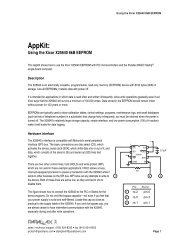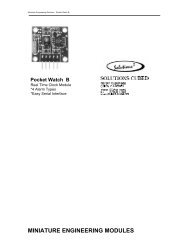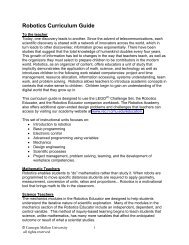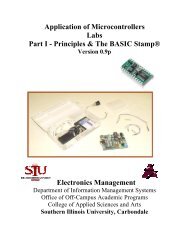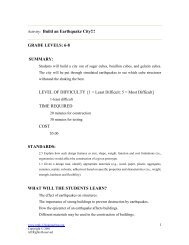Basic Stamp 2 Robot Programming - ISL
Basic Stamp 2 Robot Programming - ISL
Basic Stamp 2 Robot Programming - ISL
You also want an ePaper? Increase the reach of your titles
YUMPU automatically turns print PDFs into web optimized ePapers that Google loves.
<strong>Basic</strong> <strong>Stamp</strong> 2 <strong>Robot</strong> <strong>Programming</strong> 6-23<br />
how the code is “actually” implemented. In several of these sections, I have defined<br />
some basic rules that you should follow when you develop your own BS2 code for the<br />
TAB Electronics Build Your Own <strong>Robot</strong> Kit.<br />
1. After power is applied to the robot, a delay of 100 msecs is made to make sure<br />
that the robot’s on board microcontroller has had an opportunity to power up<br />
and that the regulated power has stabilized. You should always wait a<br />
minimum of 100 µsecs before acessing the microcontroller on the robot.<br />
2. A “Flag” is a variable that is used to save a previous state or indicate what<br />
else has been happening. In this case, the bit variable “Flag” is used to<br />
indicate whether the “ouch” message was printed during the previous time<br />
through the loop. This statement is the first one after the “OuchlessLoop”<br />
label. If neither collision sensor was active after being polled, then the Flag<br />
is reset so that the program can test to see whether or not either of the<br />
collision sensors was active during the previous poll. If they weren’t, then<br />
the “Ouch” message can be printed. The variable “Flag” is declared at<br />
indicator (0) of the application source code listed below.<br />
3. The “Loop” label is used to indicate the start of an “inner” loop to<br />
“OuchlessLoop” where execution returns if the collision sensors indicate<br />
that something is in the robot’s way. After this label, a delay of 500 msec<br />
(“pause 500”) was inserted so that the microcontroller in the robot could<br />
execute without being continually “commanded” by the BS2. In all your<br />
applications, you should wait a minimum of 20 msec before sending a new<br />
command or poll a state of the robot.<br />
4. The IR proximity detectors (“collision sensors”) are polled, and if there is no<br />
collision execution jumps to “OuchlessLoop” and “Flag” is cleared. If there is<br />
a collision, then execution continues to the following statements.<br />
5. The IR proximity detectors have indicated that there is something within<br />
collision range of the robot. The BS2 code turns on and off the LED with<br />
half-second (500-msec) delays.<br />
6. The “Flag” variable is tested to see if it is currently set. If it is, execution<br />
returns to loop where the LED will be polled again after a 500-msec delay. If<br />
“Flag” is not set, execution continues to the following statements.<br />
7. The “Flag” variable is set to indicate that the code that prints the “Ouch”<br />
message has executed for this collision. After the flag is set, the “Ouch”<br />
message is sent to the controlling PC via the PBASIC “debug” function.<br />
8. After the “Ouch” message is printed, execution jumps back to the “Loop”<br />
variable. Notice in this program that there is no way for the execution of the<br />
application to continue past this statement except to invoke the subroutines<br />
that command or poll the robot. This “goto Loop” statement is what makes<br />
this application an “endless loop”—it will never stop executing but instead<br />
will continually loop around, polling the IR proximity detectors.<br />
To command and poll the TAB Electronics Build Your Own <strong>Robot</strong> Kit from the<br />
BS2, I have created two simple subroutines that will perform the communications for<br />
you. To make things even simpler for you, I have included them along with a series<br />
of constant defines that can be a reference for you and help you understand how the<br />
interface works.<br />
To send a command to the robot, the code



